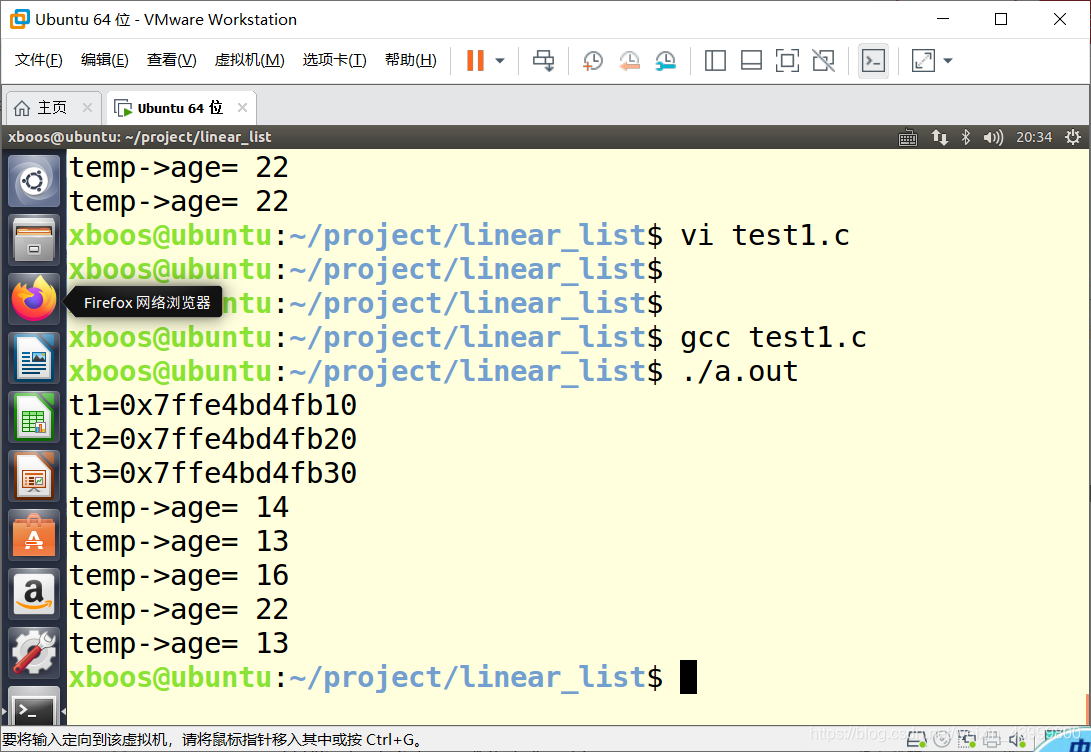数据结构顺序线性表表实现
/*****************************************************
> File Name : test.c
> Author : xboss
> Mail : 2366006417@qq.com
> Created Time: 2020年06月13日 星期六 15时14分59秒
*****************************************************/
#include<stdio.h>
#include<stdlib.h>
#include<unistd.h>
#include<string.h>
typedef void SeqList;
typedef void SeqListNode;
typedef unsigned int ElemType; //地址(指针指向数据类型)
typedef struct _tag_SeqList
{
int length; //顺序线性表的当前长度
int capacity; //当前分配的存储容量(以sizeof(ElemType)为单位)
ElemType **node; //存储空间基地址(数据元素的首地址)(二级指针相当于指针数组int *a[])
}TSeqList; //顺序线性表的类型定义
/***************************************
function :顺序线性表创建
parameter:int capacity(分配的容量)
return :顺序线性表数据对象的首地址
****************************************/
SeqList* SeqList_Create(int capacity)
{
int ret = 0;
TSeqList *temp = (TSeqList *)malloc(sizeof(TSeqList));
if(temp == NULL)
{
ret = -1;
printf("SeqList_Create error: %d\r\n",ret);
return NULL;
}
memset(temp,0,sizeof(TSeqList)); //动态分配后先赋值,置0
//根据capacity值去动态分配节点内存空间
temp->node = (ElemType **)malloc(sizeof(ElemType *)*capacity);
if(temp->node == NULL)
{
ret = -2;
printf("SeqList_Create error: %d\r\n",ret);
return NULL;
}
temp->capacity = capacity;
temp->length = 0;
return temp;
}
/***************************************
function :顺序线性表删除
parameter:顺序线性表数据对象的首地址
return :无
****************************************/
void SeqList_Destory(SeqList *list)
{
TSeqList *tlist = NULL;
if(list == NULL)
{
return ;
}
tlist = (TSeqList *)list;
if(tlist->node != NULL)
{
free(tlist->node);
}
free(tlist);
}
/***************************************
function :顺序线性表清空(清空链表,回到初始状态)(长度清空)
parameter:顺序线性表数据对象的首地址
return :无
****************************************/
void SeqList_Clear(SeqList *list)
{
TSeqList *tlist = NULL;
if(list == NULL)
{
return ;
}
tlist = (TSeqList *)list;
tlist->length = 0;
}
/***************************************
function :顺序线性表分配的存储容量(以sizeof(ElemType)为单位)查询
parameter:顺序线性表数据对象的首地址
return :返回顺序线性表的分配的存储容量,失败返回-1
****************************************/
int SeqList_Capacity(SeqList *list)
{
TSeqList *tlist = NULL;
if(list == NULL)
{
return -1;
}
tlist = (TSeqList *)list;
return tlist->capacity;
}
/***************************************
function :顺序线性表的长度计算
parameter:顺序线性表数据对象的首地址
return :返回顺序线性表的长度,失败返回-1
****************************************/
int SeqList_Length(SeqList *list)
{
TSeqList *tlist = NULL;
if(list == NULL)
{
return -1;
}
tlist = (TSeqList *)list;
return tlist->length;
}
/***************************************
function :向顺序线性表指定位置插入元素
parameter:顺序线性表数据对象的首地址(SeqList *list),元素数据(SeqListNode *node),位置(pos)
return :成功返回0,失败返回-1
****************************************/
int SeqList_Insert(SeqList *list,SeqListNode *node,int pos)
{
int ret = 0;
int i = 0;
TSeqList *tlist = NULL;
if(list == NULL || node == NULL || pos < 0 )
{
ret = -1;
printf("SeqList_Insert err:%d\r\n",ret);
return ret;
}
tlist = (TSeqList *)list;
//判断顺序线性表是不是满了
if(tlist->length >= tlist->capacity)
{
ret = -2;
printf("SeqList_Insert err:%d\r\n",ret);
return ret;
}
//容错处理(例如:当前长度为6,容量为10,用户在8处插入元素需要做容错处理)
if(pos >= tlist->length)
{
pos = tlist->length;
}
//***元素后移
for(i = tlist->length;i > pos;i--)
{
tlist->node[i] = tlist->node[i-1];
}
//在pos位置插入元素
tlist->node[i] = node;
//长度加1
tlist->length++;
return 0;
}
/***************************************
function :顺序线性表每个位置的值查询
parameter:顺序线性表数据对象的首地址,查询的位置pos
return :返回顺序线性表对应位置的地址,失败返回NULL
****************************************/
SeqListNode* SeqList_Get(SeqList *list,int pos)
{
int ret = 0;
TSeqList *tlist = NULL;
if(list == NULL || pos < 0 )
{
ret = -1;
printf("SeqList_Get err:%d\r\n",ret);
return NULL;
}
tlist = (TSeqList *)list;
return (SeqListNode*)tlist->node[pos];
}
/***************************************
function :删除顺序线性表指定位置的值
parameter:顺序线性表数据对象的首地址,删除的位置pos
return :返回顺序线性表对应位置的地址,失败返回NULL
****************************************/
SeqListNode* SeqList_Delete(SeqList *list,int pos)
{
int ret = 0;
int i = 0;
TSeqList *tlist = NULL;
SeqListNode *temp = NULL;
if(list == NULL || pos < 0 )
{
ret = -1;
printf("SeqList_Delete err:%d\r\n",ret);
return NULL;
}
tlist = (TSeqList *)list;
//将删除位置的地址保留
temp = (SeqListNode *)tlist->node[pos];
//元素前移
for(i = pos+1;i<tlist->length;i++)
{
tlist->node[i-1] = tlist->node[i];
}
//长度减1
tlist->length--;
return temp;
}
typedef struct teacher
{
int age;
int high;
}Teacher;
int main(void)
{
Teacher t1,t2,t3,t4;
int ret = 0;
int i = 0;
t1.age = 22;
t1.high = 110;
t2.age = 13;
t2.high = 130;
t3.age = 14;
t3.high = 140;
t4.age = 16;
printf("t1=%p\r\n",&t1);
printf("t2=%p\r\n",&t2);
printf("t3=%p\r\n",&t3);
SeqList *list = NULL;
//创建顺序线性表
list = SeqList_Create(5);
if(list == NULL)
{
printf("SeqList_Create\r\n");
exit(1);
}
//向顺序线性表插入数据
ret = SeqList_Insert(list,&t1,0);
ret = SeqList_Insert(list,&t2,0);
ret = SeqList_Insert(list,&t3,0);
ret = SeqList_Insert(list,&t4,2);
//遍历顺序线性表中的元素
for(i = 0;i<SeqList_Length(list);i++)
{
Teacher *temp = (Teacher *)SeqList_Get(list,i);
if(temp == NULL)
{
printf("error");
exit(1);
}
printf("temp->age= %d\r\n",temp->age);
// printf("temp->high= %d\r\n",temp->high);
}
//删除顺序线性表中的元素
SeqList_Delete(list,0);
Teacher *temp = (Teacher *)SeqList_Get(list,0);
printf("temp->age= %d\r\n",temp->age);
return 0;
}
代码运行结果























 228
228

 被折叠的 条评论
为什么被折叠?
被折叠的 条评论
为什么被折叠?








